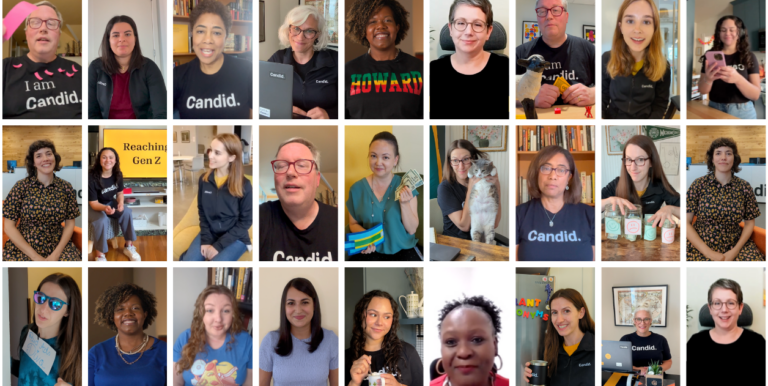Tips for nonprofits from Candid’s year of TikTok, Instagram Reels, and YouTube Shorts

Today, we are celebrating our first anniversary of short-form video on TikTok, Instagram Reels, and YouTube Shorts. What began as a three-month experiment has now blossomed into a consistent social media video production program.
While we are definitely not experts (every day we discover something new), we wanted to share what we have learned over the past year doing social media video. Here is a snapshot of what happened and our tips for creating short-form videos at your nonprofit.
A snapshot of a year of video at Candid
Over the past year, we created over 100 videos, featuring more than a dozen Candid staff members. That led to over 250,000 views and 13,000 engagements on TikTok, Instagram Reels, and YouTube Shorts.
Our goal for these videos has always been to reach younger audiences and those with a preference for video content, as well as captivate our existing followers on social media. While video views are nice, we measure our success by engagement—using likes, comments, saves, or shares as our metrics.
| Social media platform |
Number of videos |
Engagements, short form video only |
Percentage change in overall engagement, year over year |
Total video views |
Followers added |
|---|---|---|---|---|---|
| 86 | 4,603 | 113.4% | 81,294 | 1,799 | |
| YouTube | 64 | 712 | 118.45% | 32,870 | 2,066 |
| TikTok | 106 | 7,724 | N/A | 130,665 | 1,526 |
In general, videos get more engagement than our static posts. But they also bring attention to our entire social platform’s content. Engagement has more than doubled across all our Instagram and YouTube content since we started. These results convinced us to make video a permanent part of our social media strategy.
Tips for nonprofit short-form video creation
The way we make videos has changed so much over the last year. We asked Candid staff who participated in video production to share what they learned; here are our top five lessons.
1. Create more than one video at a time
When staff create videos, they often record three to four at the same time. There are a couple reasons why we do this. First, it saves time and energy. Setting up to record video takes time, whether it’s prepping the space or getting yourself camera-ready. This way, you only need to prepare once to film a few pieces of content.
Second, it gives us a backlog of content. Having a library of pre-made videos is helpful for the days when planned content falls through. Then, you won’t need to scramble to create something new.
2. Make video part of your broader content workflow
Consider how video script writing can fit into the broader way you create content. We tie our videos to our blog posts. This can mean creating a video that gets expanded into a blog or shortening a blog into a video script.
A great example is our red flags for funders series. It started as a 90-second video script. We later expanded it into a blog post. Then, we repurposed it into four shorter 15-second videos and featured it in our email newsletter. Consider how you can transform one video into other types of content.
3. Post across all short-form video platforms
Not only does re-posting across platforms mean you get more mileage out of your content, but different social media platforms also have different audiences. A video we posted to TikTok on red flags for funders got over 45,000 views but only a couple thousand on YouTube Shorts.
As long as your video is under 60 seconds, it is easy to repost across platforms. Just make sure to remove any platform-specific watermarks. You can use free tools like MusicallyDown or SnapInsta.
4. You don’t need to do trends
A persistent social media myth is that you need to participate in trends if you do video. You don’t. It can be hard to find ones that are appropriate and fit with your cause. Additionally, following trends is difficult for nonprofits when you take copyright challenges into account (organizations aren’t permitted to use a lot of trending audio).
Most of our top videos are good old-fashioned advice, delivered first-hand by one of our staff. Yes, we have done trends and used popular audio, but they don’t perform better than our other content.
5. Video production takes time and energy
Even with a year of experience and better planning techniques, making videos still takes quite a bit of time. From script writing to editing videos to moderating comments, it’s a lot of work. This is why we reduced our video production volume to just two per week.
Creating engaging videos also takes energy. You can tell when someone is excited to be onscreen. If our staff isn’t feeling it, we postpone the recording. Give your onscreen talent time and space to film, so they can be in the right mood. And never force anyone to make content.
What happens next?
Candid is going to keep making videos for Instagram Reels, TikTok, and YouTube Shorts. Now, we’re investigating whether different types of videos resonate with our audience. Our most recent experiment is doing sketches like the ones on generational differences or social media myths for nonprofits.
We’re excited to keep exploring video and what it can do to help more nonprofits.
What type of videos do you want to see from us? Share your ideas in the comments below!







